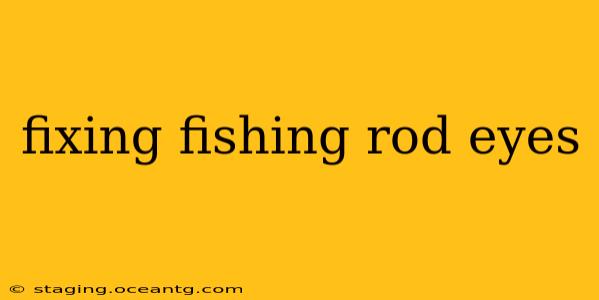Fishing rods are precision instruments, and the guides (often called "eyes") are crucial for smooth line flow and preventing friction. A damaged or loose guide can significantly impact your casting distance and overall fishing experience. This comprehensive guide will walk you through diagnosing the problem and various methods for fixing fishing rod eyes, from simple repairs to more involved solutions.
Why are My Fishing Rod Eyes Broken or Loose?
Several factors contribute to damaged or loose fishing rod eyes. Understanding the cause can help prevent future issues.
- Impact Damage: Dropping your rod, bumping it against rocks, or snagging it on submerged objects can easily crack or loosen guides.
- Wear and Tear: Constant friction from the fishing line, especially with abrasive lines, gradually wears down the guide's ceramic or metal inserts.
- Overtightening: Over-tightening the guide's retaining ring can crack the rod blank or damage the guide itself.
- Corrosion: Exposure to saltwater or other corrosive elements can weaken and damage the guide's frame and insert.
How Do I Know if My Fishing Rod Eyes Need Repairing?
Several signs indicate that your fishing rod eyes require attention:
- Loose Guides: If you can easily wiggle a guide, it's loose and needs fixing. This can lead to line tangles and breakage.
- Cracked or Chipped Guides: Cracks or chips in the guide's ceramic insert can cause line abrasion and breakage.
- Rough Guide Inserts: A rough or pitted insert creates friction, affecting casting performance.
- Line Snagging: Frequent line snagging on a particular guide is a clear indication of a problem.
How to Repair Loose Fishing Rod Eyes?
For loose guides, a simple fix might suffice:
- Tightening the Retaining Ring: Carefully use pliers (ideally, specialized guide pliers) to gently tighten the retaining ring. Avoid over-tightening, as this can damage the rod blank. Use a thin piece of cloth or rubber between the pliers and the ring to prevent marring.
How to Replace a Broken Fishing Rod Eye?
Replacing a broken guide requires more skill and tools:
- Tools Needed: You'll need a soldering iron, epoxy resin specifically designed for fishing rod repairs, a new replacement guide (matching the original size and material), and possibly a guide threader.
- Process: This involves carefully removing the old guide, cleaning the rod blank, and applying epoxy to secure the new guide in place. This is a more delicate procedure; watching videos demonstrating the process is highly recommended before attempting it. Accuracy is vital to avoid damaging the rod blank.
What Type of Epoxy Should I Use to Repair Fishing Rod Guides?
The best epoxy for repairing fishing rod guides is one specifically formulated for this purpose. It should be high-strength, flexible, and resistant to the elements. Check sporting goods stores or online retailers for products designed for fishing rod repair.
Can I Repair a Cracked Ceramic Guide Insert?
Unfortunately, repairing a cracked ceramic guide insert is typically not feasible. The best approach is to replace the entire guide. Attempting a repair is often more likely to cause further damage or lead to an ineffective repair.
How Much Does It Cost to Repair Fishing Rod Guides?
The cost of repair varies widely depending on the extent of the damage and whether you perform the repair yourself or take it to a professional repair shop. Simple tightening may cost nothing, while replacing multiple guides could cost several tens of dollars. Professional repairs are typically more expensive, ranging from a few dollars per guide to more significant sums for extensive repairs.
How to Prevent Future Damage to Fishing Rod Eyes?
Prevention is always better than cure. Here are some tips:
- Proper Storage: Store your fishing rod in a protective case or rod sleeve to minimize the risk of damage.
- Careful Handling: Handle your rod with care to avoid dropping or bumping it.
- Regular Inspection: Periodically inspect your guides for any signs of damage or wear.
- Appropriate Line Selection: Use fishing lines that are appropriate for your rod and fishing style. Avoid using excessively abrasive lines.
By following these tips and repair methods, you can prolong the lifespan of your fishing rod and maintain its optimal performance. Remember, if you're unsure about any part of the repair process, it's always best to consult a professional fishing rod repair service.
